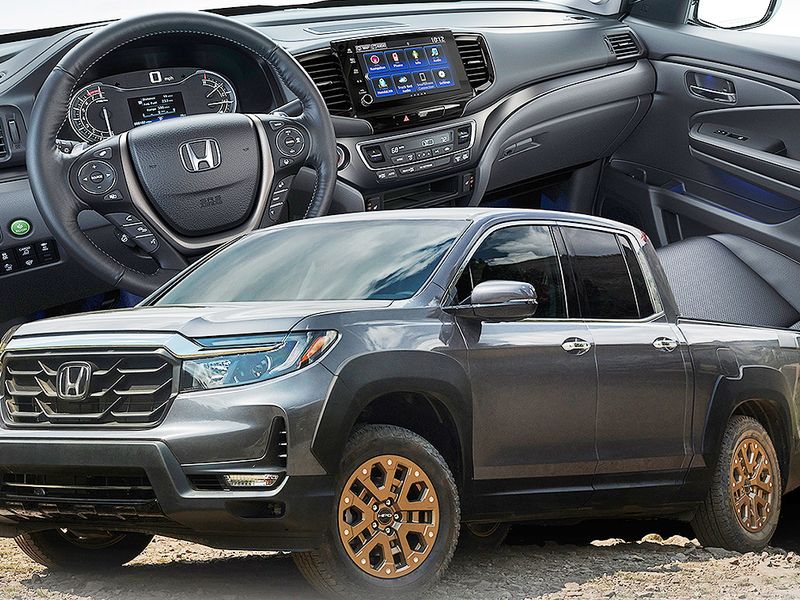
LOS ANGELES — Honda’s Ridgeline has long been odd truck out in the growing midsize pickup segment.
It is based on a front-wheel-drive unibody crossover. Its crew-cab looks are angular and soft. And for a small truck, it is remarkably roomy and fun to drive, thanks to its car-based platform.
But America’s pickup buyers vote with their wallets for tall, chunky and relatively cramped rear-wheel-drive competitors with body-on-frame architecture and a bouncy ride. Exhibit A is the Toyota Tacoma, with sales of 238,806 last year for the top spot in the category.
For 2021, Honda will try to split the difference, introducing a midcycle exterior design freshen that moves the product closer to its better-selling competitors.
The Ridgeline going on sale this week has new sheet metal from the front roof pillars forward, a flatter hood, squared nose and upright grille.
To burnish its truck credentials, it will also come standard with all-wheel drive.
But the pickup now also carries a base price of $37,665 with shipping — the highest entry price in its segment.
Industry analysts say the new look is the right move for Honda, but it still leaves the Ridgeline in a lonely space. Hyundai and Ford are now working on compact, unibody lifestyle pickups with much lower sticker prices, while the midsize crowd is getting bigger and more rugged with each redesign.
“It is a solution that’s a little off-center but also has some packaging and comfort benefits,” IHS Markit principal automotive analyst Stephanie Brinley said of the Ridgeline move. “Honda’s expectations are relatively modest. I don’t think they really believe the truck is going after hardcore truck owners. Having a more rugged look is in alignment with current truck trends.”
Ridgeline sales last year were 32,168 — sixth place among the seven pickups in the category. Every other entry was a body-on-frame design touting trucklike tasks such as towing and off-road driving. And most of Honda’s rivals have stripped base models that start around $28,000 with shipping, although they don’t include the extensive list of standard equipment on the Honda.
Honda’s first stab at the Ridgeline was discontinued in 2014. The model is now in its second generation, which started with the 2017 model year.
Generally, it has been highly rated by auto reviewers as an excellent choice for most buyers, even though consumers want the traditional truck look.
But Honda isn’t making any excuses for the capabilities of the Ridgeline as a unibody vehicle. Indeed, the brand says it plans to update the looks of all of its light trucks to better reflect their robust construction and innovative awd system, called i-VTM4.
“We have a very strong light-truck lineup. It’s just making sure that customers realize what we have, what our capability is,” Art St. Cyr, vice president of automobile operations at American Honda, told Automotive News at an October event. “People don’t realize what they can do.”
Jay Joseph, vice president of American Honda’s marketing division, said that, based on the freshening and marketing campaign, the brand is aiming for Ridgeline sales of 50,000 a year.
Honda is leveraging its long history as a maker of motorcycles, all-terrain vehicles, generators and other outdoor equipment as part of the marketing effort. In one video ad, the Ridgeline carries two motorcycles along a rocky mountain road and crosses a stream.
At the same time, Honda has developed a new version of the Ridgeline for 2021 in collaboration with its performance arm, Honda Performance Development. The HPD package adds $2,800 to the price and features black fender flares and a unique grille treatment for an even boxier look.
While some Honda dealers in the past have put a body-on-frame pickup on their wish list, the automaker hasn’t shown interest in that kind of investment. For now, the Ridgeline freshening seems to be well received by retailers and could result in additional sales.
“Dealers were asking for a Ridgeline with a more aggressive stance,” said William Feinstein, chairman of the Honda National Dealer Advisory Board and president of Planet Honda in Union, N.J.
“The issue with the Ridgeline has never been its capabilities or how it drives or its performance,” Feinstein said. “People love the vehicle. It frankly just wasn’t packaged well enough. … They’ve addressed a lot of those issues, and I expect the Ridgeline to do very well.”
The freshened pickup also is an early example of where the brand intends to go with updated designs to its midsize Passport and Pilot crossovers in the short term, and perhaps to the compact CR-V when a new generation is due in a couple years, Honda executives have said.
“You’re seeing a more aggressive style across all of Honda’s lineup, and as we get more redesigns, I’m expecting more aggressively styled vehicles,” Feinstein said.
For now, the Ridgeline continues to occupy a unique space in the market, for better or worse. And observers believe the freshened model on sale Tuesday, Feb. 2, is likely a small step in the right direction.
“As well as midsize trucks have done in recent years, their sales volumes still pale in comparison to the full-size truck market,” said Jessica Caldwell, executive director of insights at Edmunds. With only a smaller, unibody pickup, she said, “Honda will never get a piece of that high-volume, high-margin market.
“A tougher, more true trucklike appearance will help with buyer consideration,” she said. “But price-to-size ratio and other options in the market will always be the Ridgeline’s Achilles’ heel.”